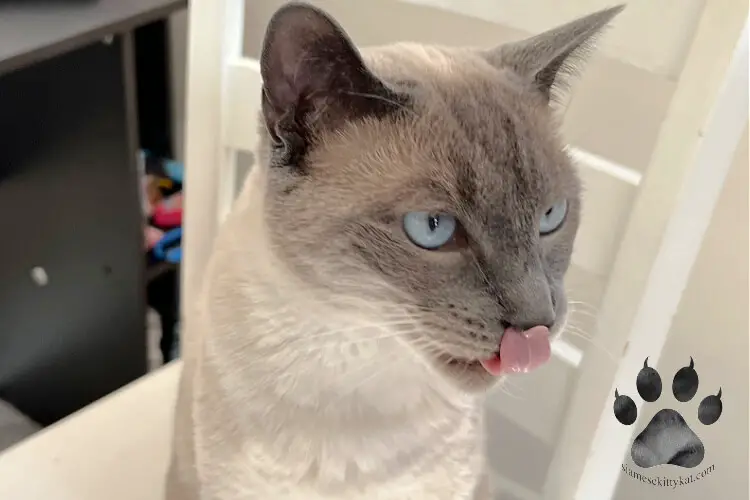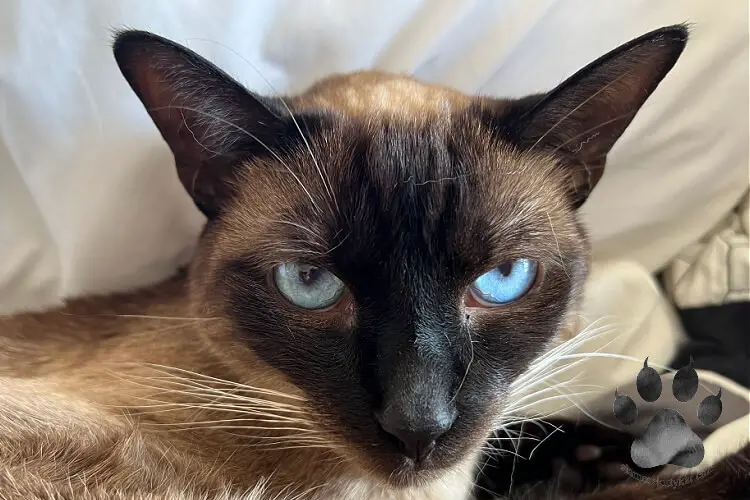Have you ever noticed your cat’s nose has a wet, slimy feel? I always wondered why my Siamese cats’ nose is always damp and what purpose it serves.
I figured out the reason behind it after doing some research. It turns out this is a common trait among cats in general.
A cat’s nose is comprised of sweat glands, which secrete moisture to help keep the feline cool. It helps moisten the outside of their nostrils for better scent detection.
Let’s take a look at what causes a wet nose in cats. Read on to learn more.
Why are Siamese Cats’ Noses Wet?
You know the strange feeling of a wet nose pressed against your hand when your cat seeks attention. There are actually many reasons why your cat’s nose could be moist.
1. The most obvious factor is the rhinarium, the skin around the nostril openings of a cat’s nose. This contains sweat glands that produce moisture to help regular the temperature of a cat’s body. This keeps your kitty cool in hot climates or when they become overly active.
The moisture created by these sweat glands evaporates off the surface of the nose. This results in a wet appearance of the cat’s nose.
A kitty licking her nose can also increase moisture levels. It gives added protection from harsh weather conditions.
2. Cats are sensitive to smells and rely heavily on their noses to understand the world around them. A cat’s nose can better pick up a scent from the environment due to its wetness. This allows cats to determine where smells are coming from.
The wetness of a cat’s nose allows scent particles to stick to it more easily than if it were dry. It also prevents dust and dirt from lodging in the nasal passages.
Cats are not the only animals with this capability. Dogs have wet noses, too, to detect odors.
3. Some cats have damp noses due to skin allergies or infections caused by bacteria or fungi. You may notice your cat licking his nose to ease the discomfort caused by these irritants entering through his nasal cavities.
Your cat needs medical attention if he shows signs of excessive
sneezing or discharge from his nostrils.
What are the Reasons for Dry Noses in Cats?

Dry noses in cats can be caused by many factors. Some of which are completely normal.
1. One common reason for a dry nose is your cat’s environment. Their nose may be warm and dry if your cat has been lying in a sunny spot or near a heating vent.
2. The dryness could be normal for your particular cat. Some cats tend to have drier noses than others. There’s no need to be concerned about nose dryness as long as your cat appears healthy.
3. Another reason why your cat’s nose may feel dry is due to grooming habits. Cats licking their noses too often can remove
the natural moisture from their noses and leave them dry.
4. Dehydration is another potential culprit for a dry nose among cats. Cats don’t always take in enough water throughout the day. Make sure plenty of fresh water is available, so your pet gets enough fluids.
Provide wet food options in place of dry kibble meals. Check with a veterinarian about proper hydration levels you should look out for.
Consider investing in a pet fountain to encourage your cat to drink more water.
5. Your cat’s nose may become warm and dry if he enjoys sunning himself in the window. This could even result in mild sunburn.
6. Cats use their tongues to draw in liquid, much like a straw. This means when cats drink from their bowl, they get water on their snout, leaving them with a wet nose.
When Should I Worry About a Dry Cat Nose?

A dry cat nose can be normal, and it doesn’t necessarily mean your cat is sick. However, it can also indicate illness, so it’s essential to know when to worry. The key is to pay close attention to your cat’s behavior and other physical symptoms it may be exhibiting.
Let’s start with the basics. A healthy cat’s nose should be slightly wet, but not dripping wet. A dry, flaky, or cracked nose could indicate dehydration or breathing difficulty.
Look for other signs such as:
These all indicate that something more serious may be happening inside your pet’s body. It’s always best to contact your veterinarian if you suspect something isn’t right with your fur baby.
Can Cats Get Sunburn on the Nose?
Cats can get sunburns on their noses. White or hairless breeds, such as Sphynx and Siamese cats, can be vulnerable due to their lack of protective fur. Your cat can still get sunburned even if he is an indoor cat.
The signs of a sunburned nose in cats are subtle yet easily detected if you look close enough. Look for signs such as redness, peeling, scaling, or irritation.
The best way to prevent a sunburned nose is to ensure your cat doesn’t spend too much time outside unprotected.
Provide your cat with ample shade when they’re outdoors. You should also use sunscreen formulated for pets.
You can keep windows covered with curtains or blinds so that direct
sunlight cannot reach inside your home.
How to Care for Your Cat’s Nose
Cats may be self-sufficient, but there are still ways to help them maintain their nose and keep it healthy. After all, your furry friend relies on its nose for smelling food and sensing the environment.
1. Maintaining cleanliness is the first step in caring for your cat’s nose. Cats often use their tongue to clean their noses during grooming sessions. However, there are times when dirt or other substances can get stuck on the delicate area of the nose.
Use a soft cloth dampened with warm water to clean it off. Gently wipe away any debris or discharge that may have accumulated.
Don’t use soap or other cleaning agents, as these can cause irritation.
Do not rub too hard or get too close to the nostrils. This could irritate your pet’s sensitive skin and cause discomfort.
2. Don’t forget regular visits with your vet, who will check your kitty’s nasal health. Your vet will check changes in your pet’s nasal health. They will compare them year after year to detect early signs of problems.
Your vet will examine your kitty’s eyes, ears, and throat to look for any signs of infection or inflammation.
3. Ensure your cat gets enough vitamins and minerals from its diet to promote good nasal health. Essential fatty acids like omega-3 are beneficial. They help reduce inflammation in the body, improving airflow through the nasal passages.
4. Make sure you’re providing proper hydration for your feline friend. Dehydration leads to poor circulation and dryness of tissues surrounding the nasal region.
5. Sunburns on cats’ noses are common. You can apply a pet-safe sunscreen before letting your cat go outside.
6. Observe the color of your cat’s nose to check if it is healthy. Healthy mucous membranes should be pinkish-red with no signs of cracking or discoloration. Consult with your vet if there are any changes in coloration or texture.
There are several reasons cats have wet noses. Some of these include helping them regulate body temperature and providing extra-sensory capabilities. There is indeed more than meets the eye when it comes to a feline’s facial features.
Want to immerse yourself more in the captivating world of Siamese cats? I’ve got all the information you need from their distinct color points to their fun personalities: Siamese Cats: Unique Features and Personality
